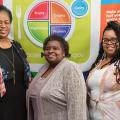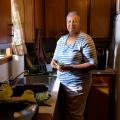Workshop 3. Fats and Sodium
Participants will accomplish the following:
Knowledge:
Understand the ABC’s of diabetes.
Comprehension:
Learn how high blood glucose, high blood pressure, and high cholesterol can affect the body.
Application:
- Identify risks related to high cholesterol.
- Identify healthy fats vs. unhealthy fats.
- Estimate serving sizes.
- Identify fats and sodium on food labels and what they mean.
- Identify healthy fat substitutions when cooking.
- Understand salt substitutes and making healthy choices.
- Learn how to use spices and herbs to flavor food. Identify resources for assistance with these topics.
Success Stories
You don’t have to have diabetes to benefit from the principles of the Dining with Diabetes (DWD) program.
Dining with Diabetes covers healthy eating, physical activity, disease monitoring, medication compliance, and risk reduction, and the course empowers participants by giving them access to nutrition knowledge and resources for food preparation. Classes include research-based education, cooking demonstrations, and healthy recipe tasting. These tools can help people make positive changes by planning menus, counting carbohydrates, controlling portions, and reading labels.
Client makes healthier choices using Extension’s Dining with Diabetes program
When it comes to changing eating habits, even if you’re ready, willing, and able, eating more nutritiously can seem like an insurmountable challenge.





